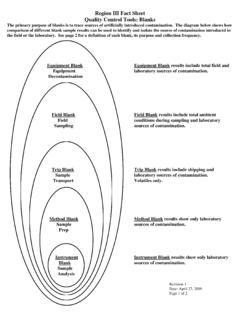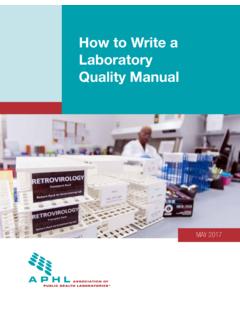Transcription of Conductivity Theory and Practice - analytical-chemistry.uoc.gr
1 - 1 -- when you need to be and Practice - 2 -PrefaceThe importance of conductivityConductivity measurement is an extremely widespread and usefulmethod, especially for quality control of feedwater purity, control of drinking water and processwater quality , estimation of the total number of ions in a solution or directmeasurement of components in process solutions can all be performedusing Conductivity high reliability, sensitivity and relatively low cost of conductivityinstrumentation makes it a potential primary parameter of any good mon-itoring program.
2 Some applications are measured in units of resistivity,the inverse of Conductivity . Other applications require the measurementof total dissolved solids (TDS), which is related to Conductivity by a fac-tor dependent upon the level and type of ions measurements cover a wide range of solution conductivityfrom pure water at less than 1x10-7 S/cm to values of greater than1 S/cm for concentrated general, the measurement of Conductivity is a rapid and inexpensiveway of determining the ionic strength of a solution. However, it is a non-specific technique, unable to distinguish between different types of ions,giving instead a reading that is proportional to the combined effect of allthe ions bookletThe subject of this booklet is the measurement of Conductivity , theability of an aqueous solution to carry an electrical current.
3 Reliable andaccurate measurements depend on a number of factors: the concentra-tion and mobility of ions, presence of organic alcohols and sugars, va-lence of ions, temperature, scope of this booklet is to discuss the theoretical aspects ofconductivity, the factors that influence the reliability of the measurement,and the techniques. Sections covering the applications, rules for reliablemeasurements and frequently asked questions have been included tomake this a comprehensive review of the importance of conductivitymeasurements.
4 - 3 -ContentsTheory of Conductivity .. 5 What is Conductivity ? .. 5 How is Conductivity measured? .. 5 What is a conductive solution? .. 6 Definition of 7 The Conductivity meter .. 10 Conductivity cells .. 112-pole 113-pole 114-pole 12 Platinised 13 Flow-through 13 Select the right Conductivity cell .. 142-pole or 4-pole cell? .. 14 Conductivity cells and measuring range .. 15 What influences the measurement? .. 16 Contamination of electrode surfaces .. 18 Geometry related errors - field effects .. 18 Frequency change .. 18 Cable 19 Cable 19 Measuring Conductivity .
5 20 Determination of the cell constant .. 20 Conductivity 21 Low Conductivity measurements (pure water) .. 21 High Conductivity measurements .. 22 Temperature 22 Linear temperature correction .. 23 Non-linear temperature 24 - 4 -Measurement 25 Contacting 25 Toroidal "Inductive" Conductivity .. 25 Rules for reliable 26 Recommendations for maintenance and 28 Applications of Conductivity measurements .. 29 Conductivity 29 Resistivity 29 TDS 30 What is TDS and how is it measured? .. 30 Determination of the TDS Factor .. 30 Calculating the sample TDS .. 31 Concentration 32 Determination of the concentration coefficients.
6 33 Determination of the sample concentration .. 34 Limitations of the concentration method .. 34 Salinity 36 Determination of the sample salinity .. 36 Build the system to suit your needs .. 37 Pure water Conductivity 40 Dedicated USP offer .. 40 Dedicated EP offer .. 40 FAQs .. 41 Conductivity tables .. 44 - 5 - Theory of conductivityWhat is Conductivity ? Conductivity is the ability of a solution, a metal or a gas - in brief allmaterials - to pass an electric current. In solutions the current is carriedby cations and anions whereas in metals it is carried by well a solution conducts electricity depends on a number of factors: Concentration Mobility of ions Valence of ions TemperatureAll substances possess some degree of Conductivity .
7 In aqueous solu-tions the level of ionic strength varies from the low Conductivity of ultrapure water to the high Conductivity of concentrated chemical is Conductivity measured? Conductivity may be measured by applying an alternating electrical cur-rent (I) to two electrodes immersed in a solution and measuring the re-sulting voltage (V). During this process, the cations migrate to the nega-tive electrode, the anions to the positive electrode and the solution actsas an electrical conductor.+++Electrical current, I---+++Voltage, VFig. 1: Migration of ions in solution - 6 -What is a conductive solution?
8 Conductivity is typically measured in aqueous solutions of are substances containing ions, solutions of ionic saltsor of compounds that ionise in solution. The ions formed in solution areresponsible for carrying the electric current. Electrolytes include acids,bases and salts and can be either strong or weak. Most conductivesolutions measured are aqueous solutions, as water has the capabilityof stabilising the ions formed by a process called electrolytesStrong electrolytes are substances that are fully ionised in solution.
9 As aresult, the concentration of ions in solution is proportional to the concen-tration of the electrolyte added. They include ionic solids and strongacids, for example of strong electrolytes conduct electricity because the positiveand negative ions can migrate largely independently under the influenceof an electric electrolytesWeak electrolytes are substances that are not fully ionised in example, acetic acid partially dissociates into acetate ions andhydrogen ions, so that an acetic acid solution contains both moleculesand ions.
10 A solution of a weak electrolyte can conduct electricity, butusually not as well as a strong electrolyte because there are fewer ionsto carry the charge from one electrode to the other. - 7 -Definition of termsResistanceThe resistance of the solution (R) can be calculated using Ohm s law(V = R x I).R = V/Iwhere:V= voltage (volts)I= current (amperes)R= resistance of the solution (ohms)ConductanceConductance (G) is defined as the reciprocal of the electrical resistance(R) of a solution between two = 1/R (S)The Conductivity meter in fact measures the conductance, and displaysthe reading converted into constantThis is the ratio of the distance (d) between the electrodes to the area(a) of the = d/aK = cell constant (cm-1)a = effective area of the electrodes (cm2)d = distance between the electrodes (cm)




